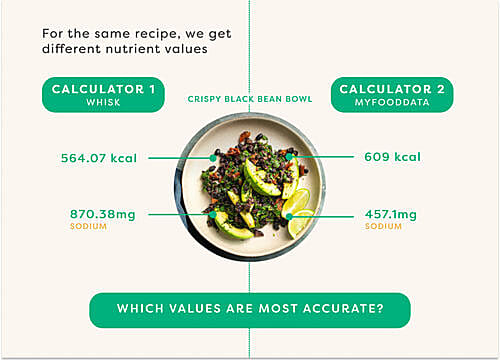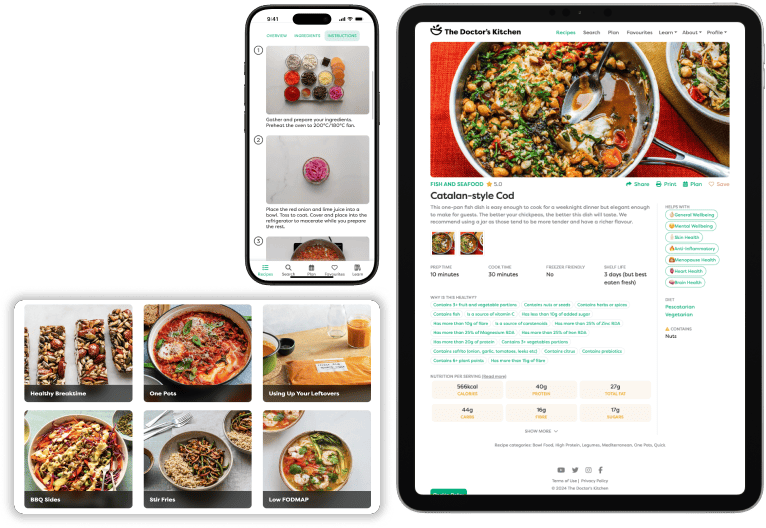Why calorie calculators are always wrong
9th Apr 2024
Figuring out the calories and nutrition facts of a recipe can be quite a puzzle. There are many nutrition calculators online, but they often give different values for the same meal. Why are nutrition facts so inaccurate?
Key points
- 1. There are many nutrition databases
- 2. The same food can have different nutritional values
- 3. Estimates are allowed
- Why is quality data important?
- How can you tell if nutritional information is reliable?
- Nutrition facts don’t tell the full story anyway…
- How to make the most of nutritional information
- Time for a change: Better food data?
- The Doctor’s kitchen’s nutrition calculator
- Dive deeper
Let’s say you’re making a simple dish like this Crispy Black Bean Bowl and you want to find out the content of calories, protein, fibre, fat, vitamins and minerals. You input the recipe into a popular online nutrition calculator. But here’s where the confusion sets in. If you try the same recipe on two different calculators, you’ll find yourself staring at two entirely different sets of numbers. Here are a few reasons why…

1. There are many nutrition databases
Calculating nutrition facts for a recipe requires gathering nutrient values for each ingredient. You get these from various food databases, compiled by government agencies, research institutions and private companies. The US Department of Agriculture particularly has performed seminal work in developing food composition databases. But many countries also have food databases like CoFID in the UK or AFCD in Australia.
Here’s the twist: Much like with nutrition calculators, if you search for the nutrient values of a simple ingredient, you’ll come across different numbers depending on the database you use. This discrepancy occurs because different food databases use various methods to collect and analyse nutrient data.

How food databases come up with their numbers: It’s quite the process. They typically gather data from various sources, such as:
- Direct chemical analyses
- Estimations from published scientific literature and laboratory reports
- Calculated values, based on preparation factors such as loss or gains of weight and estimate micronutrient changes.
- Estimated values, derived from analytical data available for similar foods
- Borrowed values, taken from other food composition databases
2. The same food can have different nutritional values
The content of calories, protein, fibre and other nutrients in foods can vary widely depending on many factors, such as:
- Plant variety and how it’s grown, like geographical location, soil, farming practices, climate and time of harvest.
- Manufacturing practices – product formulation, fortification and processing methods.
- Cooking method. For example, some nutrients like vitamin C easily degrade during cooking, so the raw value tends to be higher.

3. Estimates are allowed
Nutrient values can be approximations based on averages of similar products. Food companies and nutrition databases are not required to verify every product and are allowed a 20% margin of error on labelling – meaning that 100 calories on the label means anywhere between 80 to 120 calories.
Why is quality data important?
Accurate information on the micronutrient and macronutrient content of foods is essential for several reasons.
- Food education - It helps us understand what we’re eating and how it can affect the body.
- Informed food choices - It can guide decisions about what to eat to get a diversity of nutrients and manage health conditions.
- Research and policy: – It informs research on diet-related diseases and is used to develop dietary recommendations, public health policies and food labelling.
In essence, nutrient data informs many areas of nutrition. Ensuring the highest quality possible is essential.
How can you tell if nutritional information is reliable?
There are no golden rules in evaluating the accuracy of nutrient values. Generally, reputable sources like government agencies are best. But even those sometimes provide outdated and incomplete data. Here are our 5 indicators of reliable nutritional information:
✅ Source credibility: Who’s providing the data? Is it from reputable sources such as government agencies, research institutions, or well-established databases? Data from sources with a track record of reliability is more trustworthy.
✅ Transparency: Detailed information about how the data was obtained.
✅ Accuracy: Age and update frequency of each data measure. Methods change and evolve, so older data may not reflect the present-day nutrient content of foods.
✅ Data findability: Having unique persistent identifiers such as DOIs or static URLs. If a data source cannot be located despite a thorough web search, the data it contains cannot be used.
✅ Consistency: Is the data consistent with other reputable sources? Similar values across multiple sources increase confidence in the reliability of the data.
Nutrition facts don’t tell the full story anyway…
Even if you manage to calculate the exact nutritional content of your recipe, those numbers are only a rough guideline of what you are eating. They cannot encompass all the variables attached to food.
- Foods are more than a list of nutrients. They interact in complex ways that influence their impact on the body.
- We all respond to food differently. It has become clear that foods and nutrients have complex interactions with human physiology, depending on our unique biology and lifestyle, like physical activity and sleep. So, nutrients in the lab are not the same as how they are used by the body.
- The forgotten compounds in foods. Food composition databases in their current forms do not provide truly comprehensive information on the content of foods. There are many unmeasured or less-measured compounds in foods – like polyphenols, terpenes (which give many foods flavour and aroma), and various pigments. They may play essential roles in health by regulating cellular processes like carcinogen metabolism, hormonal balance, cell signalling, apoptosis, and more.
How to make the most of nutritional information
Despite the many limitations, nutritional values can help you develop a better understanding of food and how to diversify your weekly intake to meet your daily needs. As we’ve established, calorie and nutrient values are inherently imprecise, regardless of the data source. So, we think about them as general guidelines, not precise information. We use them to…
- Swap ingredients in a recipe to meet specific health needs or get more of a certain nutrient.
- Compare recipes and diversify the nutrients we’re getting in a week.
- Better understand nutrients and their food sources.
Time for a change: Better food data?
We believe better data starts with…
- Transparency about how the data is derived and its limitations
- Open data, freely available to all
- Regular reviews and updates
- Ranges over single values? When you search the nutrient content of food, you get fixed values with no nuance. It might be time to move towards more ‘dynamic’ nutritional values to reflect the inexactness of the field.
The Doctor’s kitchen’s nutrition calculator
This exploration of nutrition calculators came from developing our food dataset and calculator for the Doctor’s Kitchen app. Read more about how we built it here.
Dive deeper
We were inspired by the perspectives of…
- Dr Giles Yeo about Why Calories Don’t Count
- Food Composition Explained – an educational platform created by nutritionist and researcher Fernanda Grande
- This article published on Zoe about the food matrix and why nutrient values don’t tell us the full story
- Wietske Helle, founder of the food data company Eatiquette
- The work of Tufts University including International Dietary Data Expansion (INDDEX), Food Compass
- Resources from the European Food Information Resource
- What Makes a Food Composition Database (FCDB)?
- How Do We Go From Food Data to FCDBs?
Research papers
- An evaluation of data quality in nutrient databases - Li et al. Adv Nutr. 2023
- The unmapped chemical complexity of our diet - Barabási et al. Nat Food . 2020
- Traka et al. 2020
- Baer et al. 2019
- Access over 800 research backed recipes
- Personalise food for your unique health needs
